Travel: Aranui Voyage: Nuku Hiva Marquesas, Tahiti May 24/2022
- Lili Naveh
- May 24, 2022
- 6 min read
This is the 10th post of a trip to Tahiti, which started on May 10/2022 (here)
Day 4 -(Tuesday) - Aranui Cruise to the Marquesses

The Aranui 2nd stop at Nuku Hiva (Taiohae)
During the early morning crossing, viewing the fascinating Marquesas Islands of the South Pacific Ocean, invoked back the passengers' alert state of anticipation, which was
curbed by the previous long day, spent entirely, on the ship.
At 6:00 am many of of them were wide awake, on the ship’s 9th level, with the help of fresh brewed coffee and the freshest croissants, spectating the approach of the ship
to Nuka Hiva's shore ( called also Kaoha Nui)

While the Aranui was off-loading the cargo ordered by the locals, the 3 groups of French, German and English speakers, disembarked to the large dock, where a traditional welcoming local singers and the 4X4 vehicles were,already awaiting to take 8 people per a car, for the day's exploration of this gorgeous tropical Pacific Island.


The welcoming upon arrival at the on shore's dock
Tata Mate Mate.eccursion@gmail.com +689 87 31 38 39 87 24 74 44
Mate - a local Marquesas hunk of about 30, a divorcee father to a 12 year old son, was our driver for the day. His relatively comprehensible English was acquired thanks to numerous trip to New-Zeland and Las Vegas , the later , his favorite vacation place.
If you ever arrive to the island by plane, and need a driver/guide, Mate is your man to give you a ride from/to the airport, and/or a tour of the island.
Since 1980 Nuku Hiva is served by a single-runway airport in the northwest of the island.
Exploring the Island
Nuku Hiva is also called the “Mysterious Island.” and is the largest archipelago among the Marquesas Islands, consisting of a lush landscape, spectacular waterfalls, dramatic cliffs descending into the Ocean, 3 bays, and dense floral spots dotted with hidden ancient archeological ruins, majestic statues at places of worship.

Along the coast, black sand beaches as well as manta rays, eagle rays, various species of sharks, jackfish, tuna, swordfish and many more can also be found.
The population of about 3000 is substantially less than that encountered at the end of the 16th century when the Spaniards first sighted the island. Contacts with Europeans may have brought New World infections such as venereal disease and influenza, causing high mortality.

There is a prison on the island, which is notable for being the smallest in France. and it uses an open prison regime. Prisoners are free to use the grounds with a minimum of supervision. and if they don't follow the model, they are returned to prison in Papeete.
Taiohae

Taiohae is the main small town on Nuku Hiva island located on a former volcanic crater, which has partly collapsed into the ocean, creating a shoe horse Shark Bay where the ship docked,
is the administrative capital of the Marquesas. 2000 0f the over all 3000 inhabitants of the island reside in this town
Taiohae Bay is where Herman Melville , then a 23-year-old sailor and a friend, jumped off deserting a whaling ship in 1842. His book Typee is based on his experiences in the Taipivai valley in the eastern part of Nuku Hiva..
Robert Louis Stevenson's first landfall on his voyage on the Casco was at Hatihe'u, on the north side of the island, in 1888.

The island's spectacular islands scenery, during the day’s car ride, on its bays, its giant volcanic amphitheater dominated by towering cliffs, high waterfalls, deep valleys and canyons as well as amazing most verdant vegetation are beyond words.
Sites Visited:
Taiohae Cathedral - Notre Dame "Our Lady of the Marquesas "

The construction of this quaint major Roman Catholic Cathedral began in 1973 on the site of an earlier 19th-century church by the same name. The new cathedral opened in 1977. It is the largest church on the Marquesas Islands can sit 800 people.
The exterior walls of the church are made of wood and stone, with "elaborately carved" doors at the entrance. The stones were given by each of the six inhabited islands of the Marquesas.

It contains beautiful wood carvings relics fusing symbolic elements of the old Polynesian culture with the newer one, introduced by the European missionaries, as also reflected by the 2 towers gate, at the entrance to the compound.
There are also the 2 tombs of the bishops and a school on the premises

Interior of the church

Exterior on premise

Mila - the ship’s guide (introduced on the first day) shared info on how the original old culture was suppressed initially by the missionaries who set a range of Taboos on the local population also forbidding them the usage of their own native language.
The third bishop assigned to the islands, eased up many of the restricting Taboos, and the celebrations of many traditions, have been returning and preserved, like singing and drumming local music in the church.
Stone sculpture of Madonna and Child can be seen
The statue of Jesus Christ has been adapted to how the local inhabitants look like.
Village of Tai-Pivai - by the River


The mountainous village by a small river is where a local handicraft center selling art like carved wood pieces and red seed beads, can be found.

Also a replica of a traditional elevated stone platform part of community dwelling is constructed, and has been used for official festival gatherings. with Tiki figures on it



Hatiheu Village - UNESCO heritage “Tohua of Kamuihei”
A welcome by the old Banyan tree

A performance of the Marquesas and their traditional Pig Dance welcomed the groups upon the visit to UNESCO heritage “Tohua of Kamuihei” - largest excavated archaeological area of Nuku Hiva
In the forested depth of the mountainous island the archaeological site visited, contains: sacred giant banyans trees, original stone platforms, and petroglyphs -
that represent turtles, fish and the eyes of a tiki, along with human figures

The researcher Cecil Milgstorm estimated that the valley contains more than 500 other petroglyphs like these. carved on huge rocks - a window to the culture’s ancient past .
The importance and sheer number of these structures testify to the dense population this valley once sheltered.
The deep tangled roots of the 600 years oldest Banyon tree on site, contains the
burial place of the community’s ancient dignitaries, (Cheifs and Priests) as was the traditional Polynesian custom in the past. Now a days burial is done in. Designated cemeteries.
Man made perfect curved holes on the site’s stones, were used for containing the ink and oils.
Archeologist Dr Robert Saggs -,an American archaeologist, discovered human skulls and leg bones in the banyan tree when he excavated the site in 1956-57.
- A team led by the archaeologist Pierre Ottino began restoration in 1998.

More trees in the forest
Kukui nuts of the Ama tree grow plenty on the site , and have been used for a tasty source of nutrition , and remedy against concatenation.
Also mixing the smut of the burned nuts with coconut water (a natural antiseptic) provides the ink for the customary Tattooing, another old tradition. Beyond ornamental gestures, it communicates a specific societal status, paying tribute to legendary heroes or sacred locations, and signifying the offer of protection or fertility
Marquesian tattoos are body armor
And an elevated flat stone was used for operating medicinal practices and body Tattooing of boys coming to age
Ylang Ylang trees from which perfumes are being extracted and its grapes are favorite food of the endemic now preserved Black bird -Imperial Pigeon
And the Red Seeds of the Py-Pyon tree are used for beads jewelry making
Ylang Ylang Py-Pyon Kukui nuts
Black Bird
The small village of Hatiheu, also offers a museum that displays copies of petroglyphs from unexplored valleys, however we didn’t get to it.
Lunch at "Mama Yvonnes" Restaurant (here)

The groups were introduced to a traditional Marquesas cuisine, served for lunch, at this small eating establishment in Hatiheu by the beach.
The specialty of the “umu” - an underground oven where food of several local vegetables and a whole roasted pig, are cooked for hours, and were “spiced” also by local Polynesian music .
I had already observed this tradition on Moorea Island and were not as excited to taste the food. However the sea food dishes served prior to the meat were very tasty.
Back to Taiohae Village

Upon returning later in the afternoon, to the center of the main Taiohae Village, where a free time was located, except of the artifact center, we were disappointed to find that both the vegetable market and Internet cafe were closed.

To cheer us up, Mate the driver, suggested to drive us privately, to the Relais- Chateau, which we were surprised to find but which exists, in this remote spot on the globe.
It is one of the smallest Relais-Chateau , of only 30 rooms and is rated as a 3 stars.
After visiting it , Mate dropped us back at the dock where the ship moored..

More scenery from the island




Departure from the Island
Dinner on the Ship
The special pre-ordered lobster dinner at the ship’s pool’s deck followed by a Marquesas dance show concluded this busy fascinating day.
To be continued....









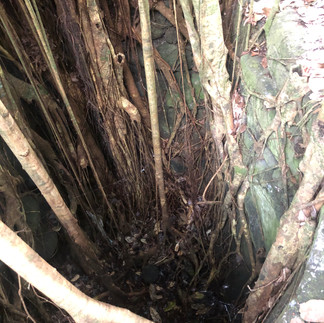



























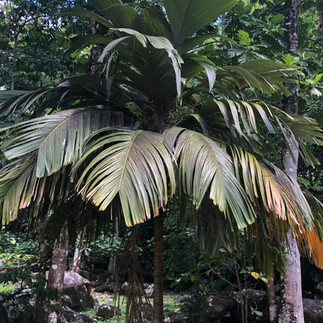







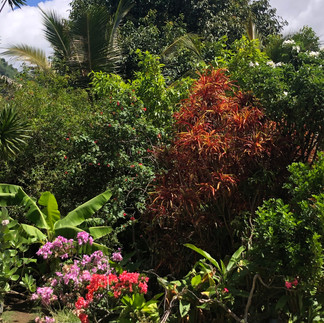















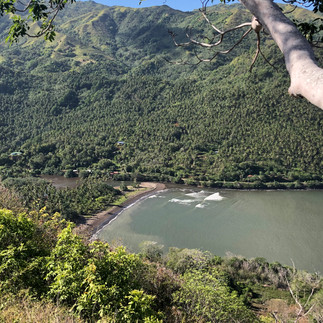

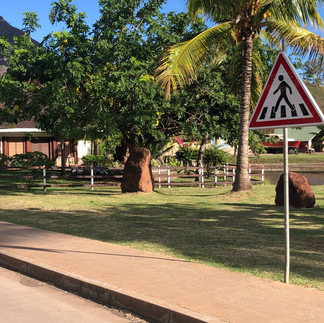







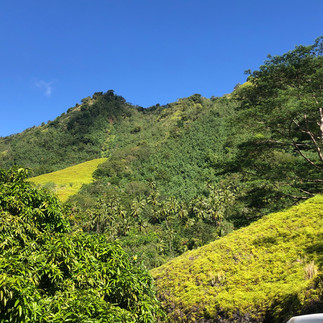















Comments